Artificial Turf vs Natural Grass: Comparing the Costs and Benefits
As the classic image to any American home, a lawn is one of the most important parts of any outdoor living area and the first impression to any guests. Other than the visual aesthetics, grass lawns serve as a space that is great for children and pets to play on. Thanks to technological advancements, we have a choice of owning a real grass lawn or fake grass lawn. But what are the main differences between the two, and is one better than the other?
Making the decision between an artificial grass or natural grass lawn is something that many homeowners struggle with. To help you decide which is best for you, we have compared the costs and benefits of each.
Note: The costs outlined below are based off Southern California pricing and will need to be adjusted based on your specific area, lawn size, and grass lawn decisions.
Artificial Grass
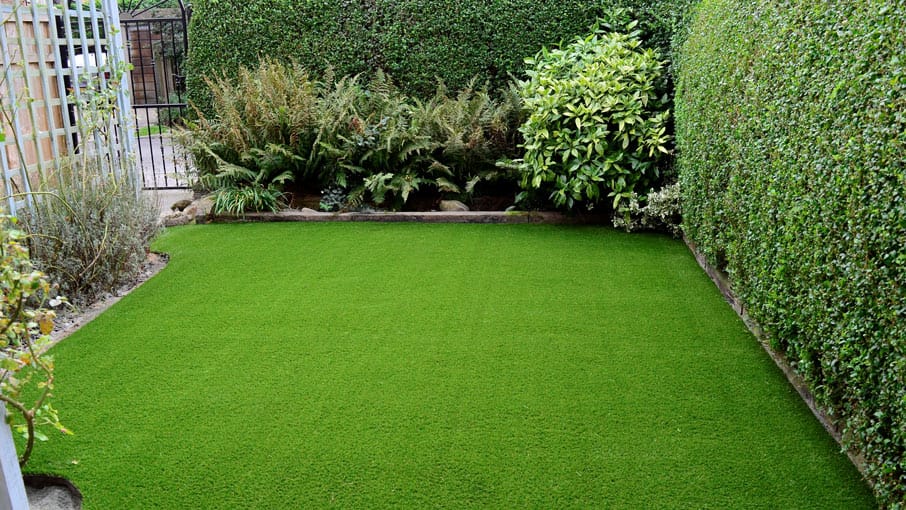
Artificial grass is composed of synthetic fibers that are made to look like natural grass, and have a lifespan of up to 25 years. Some may think that synthetic turf looks too fake, but now there are a variety of artificial grass options available.
Types of artificial turf vary from the type of material, pile height, and color. The three different materials that artificial turf is made of includes polypropylene, polyethylene, and nylon. Synthetic grass also comes in different sizes, referred to as pile height, which is the height of the grass blades. While most people would assume that artificial grass is only available in the color green, there are actually a large variety of colors available such as pink, blue, and much more.
What is important based off the different attributes above, is the way the artificial lawn area will be used. Primary use may include pet yards, putting greens, or a home lawn. For a home lawn, synthetic grass with a medium height made of polyethylene is the most popular choice. The colors will have multiple shades of green and possibly some brown to imitate the look of a healthy natural lawn.
Artificial Grass Benefits
The benefits of installing an artificial grass lawn are plentiful. Unlike natural grass, artificial grass doesn’t need much maintenance. The few maintenance items needed will be a rinse down to remove dust, periodic brushing/grooming, and raking large debris. Alongside the little maintenance needed, the best part of artificial grass is that it doesn’t require watering. This is a huge plus in areas like Southern California where water is scarce and the water rates are rising.
An artificial lawn will look great in any outdoor living space all year round, no matter what the climate or season is. The worry of diagnosing dying grass will be a thing of the past. Artificial grass is also beneficial for the environment, since harmful pesticides, fertilizers, and fungicides aren’t needed. Other environmental benefits are decreased pollutants and carbon emissions from gas powered tools like lawn mowers, as well as preservation of water.

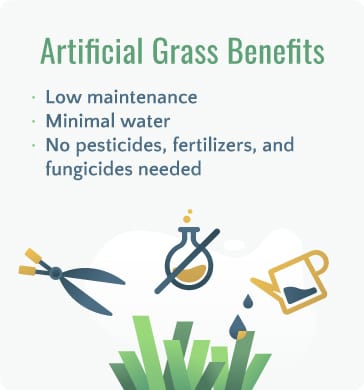
Natural Grass
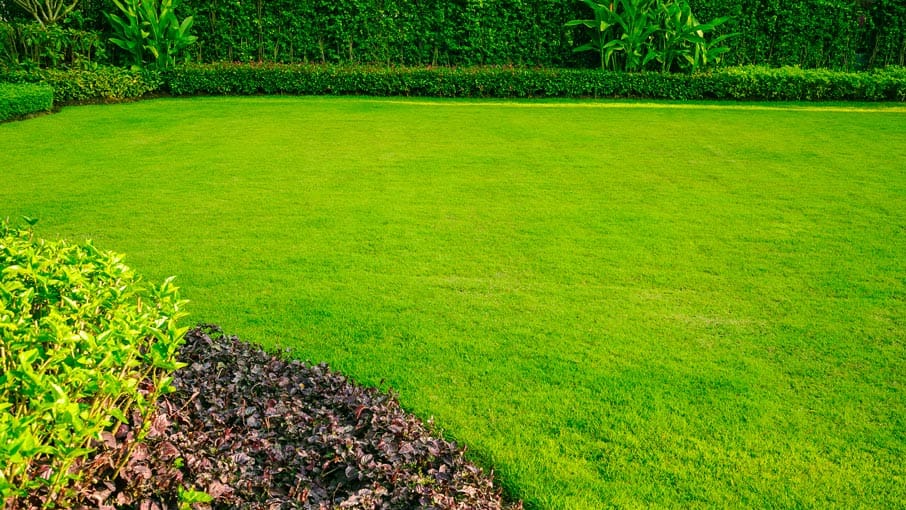
Traditional to most American homes is a natural grass lawn, which has allowed young entrepreneurs to mow lawns for decades. There are a large number of different species of grass, which vary by blade, growth, season, shade, and water requirements. Unlike artificial grass, you have to make sure you pick the right natural grass for your climate.
Some of the most popular grass species for most lawns are bent, bermuda, fine fescue, Kentucky bluegrass, ryegrass, and tall fescue. The blades for each of these species varies from narrow, flat, sharp, pointed, hair like, and even round. Some of the species grow fast, low, or in bunches. And since the grass is natural, the amount of watering can range from once every week to twice a week.
Maintaining a healthy green lawn takes time and persistence. Maintenance requires watering the lawn a certain amount at optimal times, which can be automated with the help of sprinkler systems. Lawns also have to be mowed, aerated, fertilized, and monitored for weeds and diseases. Each of these tasks are to ensure that the lawn is pulling in as much nutrients as possible so it can stay lush and green.
Implementing natural turf into your outdoor living space could be done by seeding the area or laying down sod. Sod is grass that is pre-grown by farmers and comes in rolls. Depending on the amount of effort you want to put into the lawn, sod may be the best option.
Natural Lawn Benefits
Despite any concerns of water usage in regards to natural grass, natural grass lawns have their benefits. Since the grass is natural, the lawn is able to improve the quality of air through purification. This is done through the breaking down of air borne pollutants in the soil, which is captured by the grass blades. Other environmental benefits of natural lawns are the generation of oxygen, improvement of soil quality, reduction of runoff, and cooling of the surrounding area.

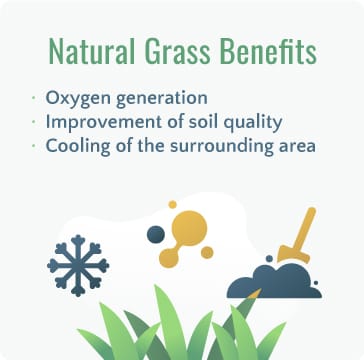
Environmental Impact
The impact an artificial grass or a natural grass field can have on the environment is important. After all, the environment is essential for our quality of life and health. Both types of grass can hurt and help the environment in their own ways.
Artificial grass is great for the environment because of the amount of water that is saved. Water is one of the most fundamental and necessary natural resources we have. Saving as much of it as possible is vital. The cons of artificial grass are the creation of pollution through manufacturing and the fact that it isn’t biodegradable.
Natural grass benefits our environment because it is a living organism. Real grass contributes to the ecosystem by supplying oxygen, filtering pollution, and absorbs heat. Alongside these benefits, natural grass has some drawbacks as well. Real grass is often sprayed with pesticides that move with the runoff water and contaminates water systems.
Installation Costs
For the costs of both grass types, the yard size will reflect a 1,000 square foot lawn.
Note: Water costs and amount of water needed will vary based on location and the species of grass you choose.
Artificial Grass Installation Costs
The installation of a synthetic turf lawn has a number of factors that contribute to the final cost. This includes materials, operation fees, labor, company overhead, and company profit. The type of grass, company, and quality of labor chosen will have a major impact on the overall cost of installation. A 1,000 square foot area would take about two to three days for a complete installation by a crew of four to five people.
Pricing by square foot starts around $9 for a quality synthetic turf installation. Assuming a grass lawn of 1,000 square feet, the installation cost will be roughly $9,000.
To learn more about the specifics of what goes into an artificial grass installation, check out our artificial grass installation price guide.
If you would like to calculate the cost for a specific project, we also have an artificial grass cost calculator.

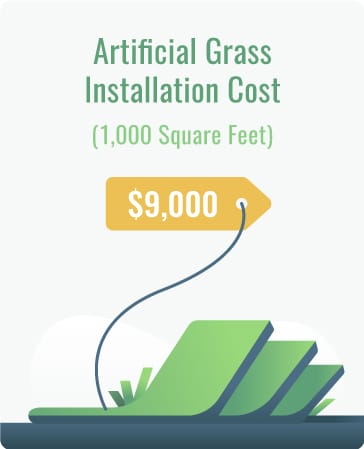
Natural Grass Installation Costs
There are two options for having a natural grass lawn – through sodding or seeding. Since sodding is pre-grown, it has a higher cost, compared to having to plant the seeds and nurture the lawn yourself.
For both sod and seed lawn installation, a lawn irrigation system or sprinkler system will need to be installed. The average cost of a sprinkler system installation is $2 per square foot, which will be $2,000 for 1,000 square feet of grass.
Pricing by square foot for installing sod starts at $3.50 with a professional installer, which includes everything from removal of the current lawn to the disposal of debris. With a lawn size of 1,000 square feet, the sod installation will cost $3,500.
The total installation cost for installing sod with a sprinkler system will cost $5,500.

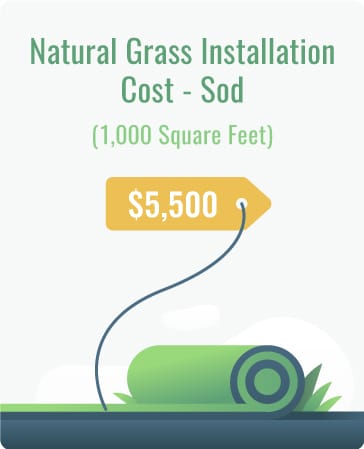
For a more affordable alternative for natural grass, seeding will cost about $0.05 per square foot when installed by yourself, or $50 for a 1,000 square foot area. Because only the seeds are being planted, the cost of installing a natural grass lawn will include thorough watering for the first eight weeks for a full lawn.
623 gallons of water or rain is equivalent to one inch of water for a 1,000 square foot area. The total amount of water needed for grass seed germination is about 40 inches of water or 24,920 gallons. This accounts for the 8 inches of moist soil needed before planting, 4 inches of moist soil immediately after planting, and 2 inches of moist soil twice a day until the seeds sprout. One inch of water soaks about 6 inches of soil. Factoring in the cost of water for a single-family domestic customer in San Diego, the cost of water based on the usage above will equal about $290 dollars (base fee of $24.74). This is exclusive to just watering the lawn, so depending on other water usage (i.e. showers, dishwashing, etc.), the cost of water can be increased by an additional 40%.
In total, growing grass from seeds to germination for a 1,000 square foot natural grass lawn with a sprinkler system will cost $2,340.

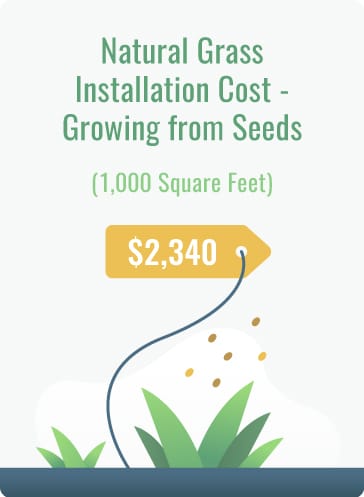
Care and Maintenance Costs
Considering the lifespan of an artificial grass lawn is 25 years, we will use that as the time frame for care and maintenance costs.
Artificial Grass Care and Maintenance Costs
The beauty of owning an artificial grass lawn is the minimal care and maintenance required. Care and maintenance includes watering, brushing, and potentially using odor control if you have a dog. Because there is little care and maintenance required, the costs below will not factor in any labor.
Watering the lawn will help remove any dust or pollen that settles on top of the artificial lawn. This can be done once a month and only needs a quick hose down, maybe about a quarter of an inch of water each rinse. For a 25 year span, we will assume a cost of $300 for hosing the 1,000 fake turf area down based on current San Diego water rates.
Brushing the synthetic turf helps restore the appearance of the lawn by fluffing up the fibers that are flat in higher traffic areas. A brush will set you back about $40.
If you have pets, an odor control solution should be used when rinsing the lawn every other month. A product such as Urine Zero covers 2,500 square feet for every gallon. Costing $100 a gallon, the total cost for 25 years will be $6,000.
The sum of all the care and maintenance costs for artificial grass equal $6,340, for homeowners with a pet. For homeowners without a pet, the care and maintenance costs are about $340.

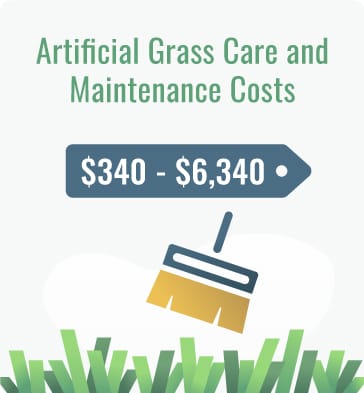
Natural Grass Care and Maintenance Costs
Maintenance and care tasks that go into a natural grass lawn involve mowing, edging, aeration, overseeding, fertilizing, weed control, and watering. Costs can be mitigated if equipment is purchased and tasks are completed by yourself. But costs that you will have to pay whether you pay a laborer for the work or not are seeds, fertilizer, weed control, and water. The costs below will factor in labor due to the amount of effort a natural grass lawn depends on.
For someone to mow, edge, and dispose of clippings for your natural grass lawn, you will be looking to pay at least $30 each visit. Depending on the climate, you should expect around two visits a month, which comes out to $720 a year. With the 25 year time frame in mind, total lawn mowing and edging will cost $18,000.
Aeration and overseeding are important to a natural grass lawn. Aeration allows air, water, and nutrients to penetrate the grass roots through the perforation of the soil. Overseeding is for filling in bare spots and improving the density of the lawn. Both of these cost about $50 per 1,000 square feet and need to be done twice a year. The entire cost for aeration and overseeding will be $2,500 for 25 years.
Fertilizers and herbicides keep weeds away and feed the grass. Fertilizing and weed control should be done about once every quarter or four times a year. The schedule for when this should be done for your lawn will depend on the grass type and climate. An average application will cost $60, or a total of $6,000 for 25 years.
Using the values mentioned above, we can find out how much water will be needed throughout 25 years. Since the water usage will be decreased due to the established grass, water costs per hundred cubic feet (HCF) or water rates will be less. Established grass needs about one to two inches of water per week. The total will be 1,950 inches or 1,214,850 Gallons of water for 25 years, costing a total of about $9,000 assuming the cost of water doesn’t change in San Diego.
Adding all the care and maintenance costs of a natural grass lawn, assuming that labor will not be done ourselves, we come to a total cost of $35,500. Again, the cost can be minimized if a lawn mower, lawn aerator, and other tools are purchased and the labor is conducted on your own.

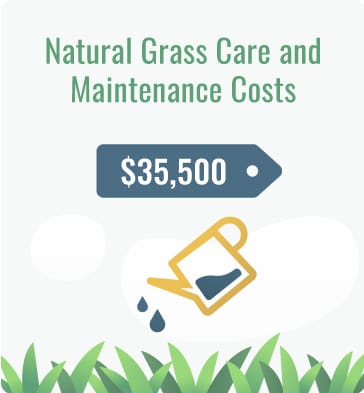
Which Type of Lawn Should You Choose?
We have shared the many benefits of natural grass and artificial turf as well as the different costs that go into each. There are many variables that can’t be accounted for, since homeowners come from different climates and may use the lawn for different reasons. From the comparison above, the cost of natural grass over time, ends up being the more expensive option. The upfront cost of artificial turf will equal the amount paid for installation and maintenance of a natural grass lawn in three to five years. Despite the high upfront costs of installing artificial grass, you will end up saving your wallet and your local water supplies in the long run.
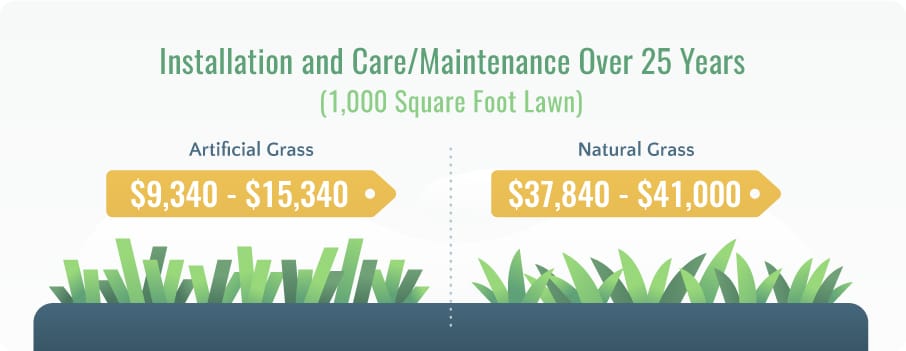
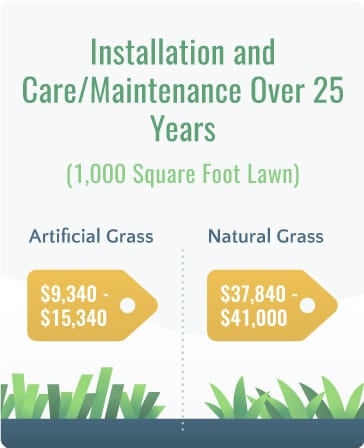
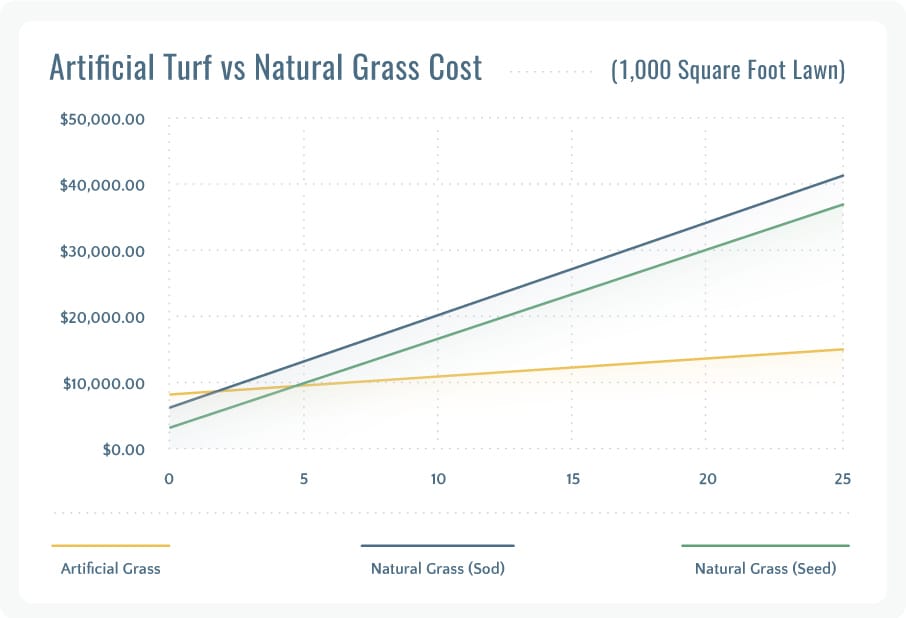
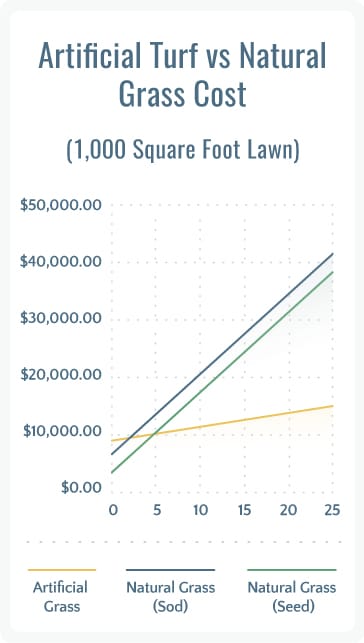
If you are interested in an artificial grass project in Southern California, please contact Install-It-Direct today to get your FREE Synthetic Turf Design and Estimate by clicking on the “Free Estimate” button or feel free to give us a call at 858-925-3000.
Sources:
Lowes | City of San Diego | G ilmour